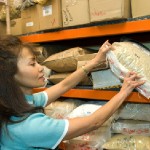There has been much written and said about the importance of storing food and water for emergencies. I think it would be difficult to find anyone who disagrees with this idea. Many victims of hurricanes Katrina and Sandy, as well as tornado victims in Oklahoma, Alabama and elsewhere, certainly wish they’d had food and water immediately available in the aftermath of those tragedies.
There is considerably less knowledge and agreement, on the other hand, when it comes to what types of food to stockpile and how to store it in a way that will maximize its use once it becomes necessary to access it. Unfortunately, many people make mistakes in this area. Sometimes, their hard work goes to waste; because just when they need it most, their stored food has gone bad or they’ve made other errors in judgment.
people make mistakes in this area. Sometimes, their hard work goes to waste; because just when they need it most, their stored food has gone bad or they’ve made other errors in judgment.
For example, you could have tons of wheat stored, but too much of any one thing is not good. Variety and balance are essential for your digestive system. Having variety and balance in your food stockpile will also help you and your family psychologically if you find yourself in an emergency situation that goes on for days, weeks or months.
The type of container in which you store your food is very important, because exposure to air and moisture can ruin your food storage plans. Where you keep those containers is also a major factor, because higher temperatures and light can negatively influence vitamins, proteins and fats. The storage temperature should be between 40 degrees and 70 degrees Fahrenheit.
Other factors include how nutritious your food is and how often you rotate it. You also want to make sure that the majority of food you store does not require refrigeration, because a power outage would spoil those foods quickly. (We’ll get into the topic of freeze-dried food in a moment.) Finally, keeping some food at a secondary location is important, should your home be destroyed in a disaster.
Following is my top 10 list of common food storage mistakes:
- Ignoring the importance of nutrition in the foods that are stored. This happens more often than you might think. Sometimes, people are so concerned about the volume of food they store that they forget about vitamin and mineral content.
- Using sacks or other containers that are not airtight. This is wrong for a variety of reasons. Air and moisture will greatly decrease the shelf life of your stored food. In addition, containers that are not airtight increase the odds of insects or a critter getting into your food.
- Failing to keep food containers in a cool, dry place. Heat and moisture are two of the chief enemies of stored food.
- Failing to keep food containers out of the light. You definitely want to go to the dark side when it comes to storing food. Light can deplete the vitamin content of food.
- Storing too many items that need refrigeration. As mentioned, it’s very likely that a crisis will include the loss of power, which could mean your refrigerated items will spoil quickly.
- Failing to include enough of a variety of different foods. After a couple of days of eating the exact same thing, you and your family are going to want some variety.
- Failing to maintain a good balance in the foods that are stored. Make sure that your various food items provide a variety of different vitamins and minerals.
- Failing to include at least a small percentage of “comfort” foods. In addition to satisfying your sweet tooth, comfort foods will be a big help psychologically for you and your family in a crisis.
- Failing to check expiration dates and rotate stored foods. In each container, organize food by expiration date. When an item’s expiration date is approaching, eat that food — or donate it to a shelter — and replace it with newer food.
- Storing all of the food in only one location. This is the classic case of putting all your eggs in one basket. If your home is destroyed in a disaster, you’ll be glad you kept food and water at a secondary location.
I’ve learned a lot about food storage over the past few months while developing a new line of emergency survival food called Food4Patriots. Freeze-drying, while definitely effective, is very expensive and strips the food of some of its vital nutrients. Another common technique in the industry is the cheaper “rapid dehydration” method that sucks all the water out quickly, but also pulls flavor and nutrients. We ended up going with a “low-heat dehydration” technique for our food so the flavor and nutrition stays locked in, yet it lasts every bit as long as freeze drying without costing an arm and a leg.
Another critical thing to look for when shopping for off-the-shelf emergency food is the packaging. It’s vital to keep air and moisture out and to have a durable package that can take a few bumps over the years without bursting. Look for sealed Mylar pouches with less than 2 percent oxygen content rather than cans or buckets.
Whether you build your own food stockpile or purchase a ready-made solution, the bottom line is that just believing that storing food and water for a crisis is a good idea isn’t enough. You actually have to do it. And when you do, make sure that it’s stored in a manner that will ensure its value and longevity. Then and only then can you rest easy, knowing that you’ve done what you could to be prepared for whatever comes our way.
Source: personalliberty.com

